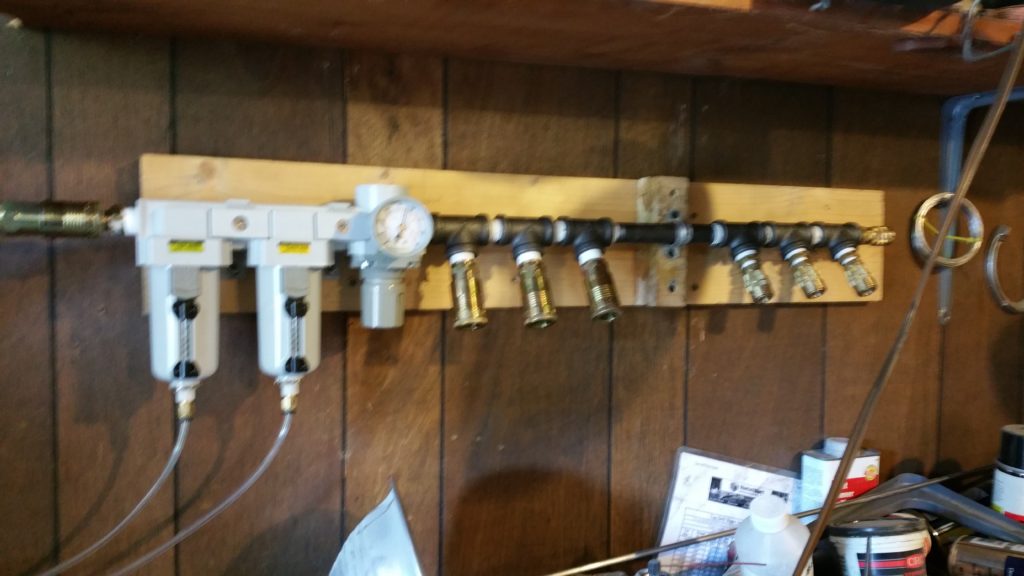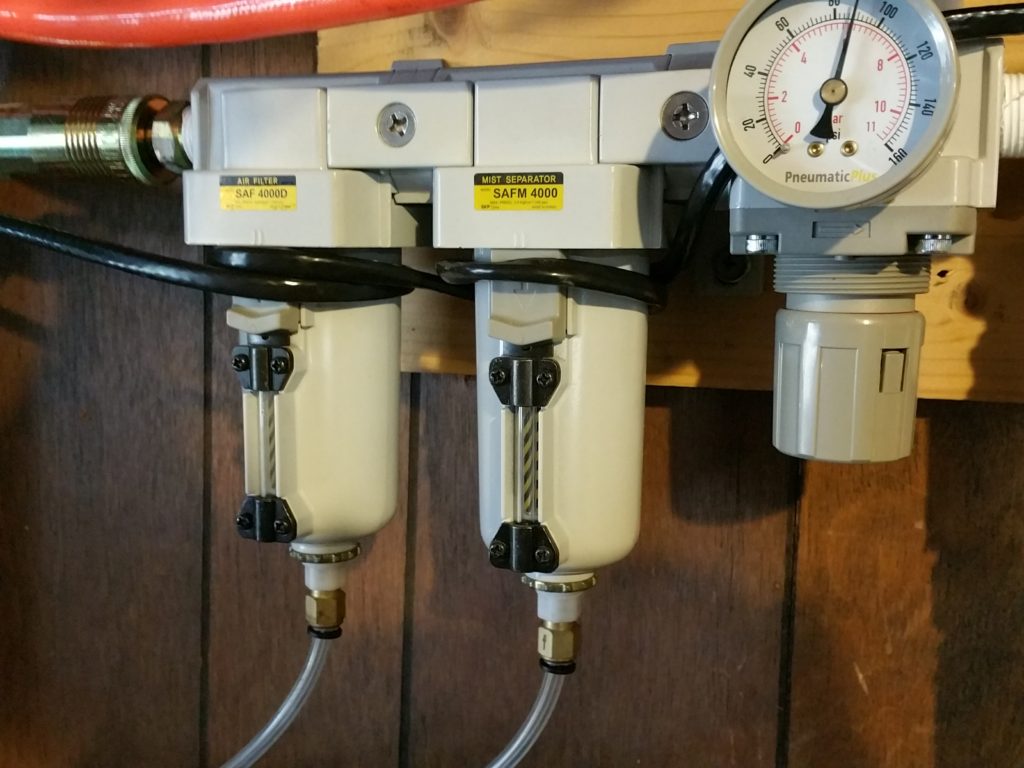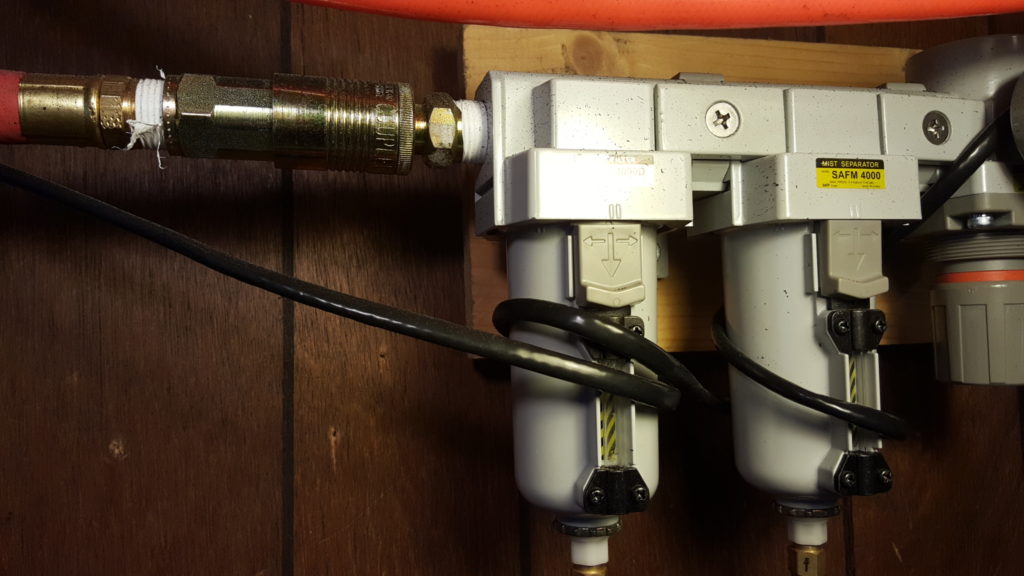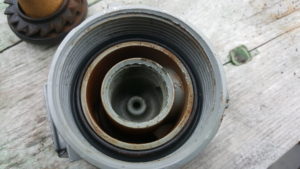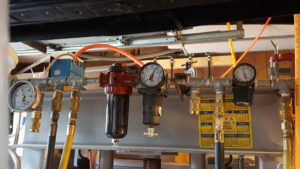If you are just jumping into this three part post, an inline compressed air filter by itself does not work very well when it comes to removing moisture from compressed air but it definite works good as a third step in a thought out moisture control strategy. If you haven’t read them yet, please read these other posts first:
- Need Dryer Shop Compressed Air? – Step 1: Drain Your Tank Regularly
- Need Dryer Shop Compressed Air? – Step 2: Add a Moisture Separation System
Now, as a third step, good filters are definitely needed. In line filters remove even more moisture and protect your regulators and equipment from debris such as rust. Filters are a good example of you get what you pay for. Those really cheap air filters aren’t up to demanding tasks. Setting shoddy construction to the side for the moment, you will notice that some do not say how fine their filter is (as measured in microns) or give you any indication of the cubic feet minute (CFM) the filter can handle. You at least need to know the first part.
Buy quality units from a reputably manufacturer. I like Milton, Parker and PneumaticPlus and they are three of many that are out there. Everything I am going to write about here, I bought with my own money and actually use or have used so this is not some thinly veiled advertisement. I’m recommending the various items because they work for me.
In terms of construction, some have a plastic/polycarbonate bowl and they are rated for lower pressures (usually 125-150 PSI) and others have metal bowls and are rated for higher pressures. For example, my Ingersol Rand 2340 stores the compressed air at 175PSI so I use metal bowls on my filters and drains exposed to that pressure. In downstream areas with lower pressure, I use filters with polycarbonate bowls.
If you are serious about filtering, you need at least a two stage unit. The first stage is a coarse air filter and will range from 5-40 microns in terms of filtering element size. The second stage will be a fine air filter and be remove even smaller particles often down to the 1 to even .01 micron level. You must have the coarse filter in front or you will plug up the fine air filter real fast and negatively impact your CFM.
When you are shopping for filters, there is an ISO standard to be aware of that some reputable filter companies will reference – ISO8573.1. Here is a good blog post if you want to learn more.
With that said, let me show you what I actually use.
My inlet air for the filter is 1/2″ because I wanted to provide a lot of flow. All of my plumbing up to that point is 1/2″ also. After doing a lot of digging, I opted for a PneumaticPlus SAU4030M-N04DG-MEP which is a combination three stage unit with a 10 micron coarse air particulate filter first, then a 0.3 Micron Coalescing Filter followed by a pressure regulator.
In researching the unit, I found that the rated inlet pressure was 250PSI and the outlet was rated at 150PSI — note these are metal bowls hence the higher pressure rating.. I planned on setting the regulator to 90PSI for my tools and found that the maximum flow would be around 38 SCFM (standard cubic feet per minute) @ 90 PSI, which also met my needs. The two filters also have automatic drains so I don’t have to worry about purging them.
You’ll note the black warmer cable in the last photo – that’s because my shop is unheated in the winter. The heated cable is on a thermal switch and only turns on at 32F. This keeps the condensate from freezing in the bowls. You’ll also note the 1/8″ tubing removing routing the condensate to drain where I want it to.
They both still collect moisture – the first filter more than the second. Every day, I can see the condensate coming out of the tank, the moisture separator and to a much lesser extent, these filters. I have been using this set up since August 2016 and really like it. I usually find zero moisture downstream but I still run basic coarse filters just before my various regulators. Attached to my plasma cutter, I still run one of their #128647 1 micron air filters just to play it safe.
Downstream, I still have in-line air filters just in case
As a rule of thumb, it is always a good idea to have an air filter just before a regulatory. Before a couple of my downstream pressure regulators, I run Milton 1018 filters and they are nice. 40 micron coarse filters with 48 SCFM. This one right here has been in use for a few years and predates the elaborate moisture control system I have in place now. Look at the rust in the bowl from when I cleaned it! I still have two of these in daily use and have no complaints.
These inline filters are all bone dry which helps me conclude the upstream moisture control is working pretty well. They are probably 50-75 feet from the tank in terms of how much line the air must flow through before reaching them. The dirty bowls are from the mess I had before the current system. I cleaned them while I was at it hence the above 1018 being disassembled. A nice feature of this model Milton is that it automatically drains when the pressure in the bowls drops to the point that a spring can pop open and let the condensate out. You can also push the rubber nipple sideways to manually drain it while pressurized. They are simple and effective coarse filters.
Now the red and black filter is a Craftsman 16009 and it is pretty low end. When my dad passed away, he left a couple of Sears gift cards that I used to buy three of these filters and some air hose. When I google them now and read on the Sears website, they do not list the microns. I suspect it is a 40-50 micron coarse filter but that lack of a rating should throw up flags. I don’t have the original packaging so I don’t know if it listed it or not. The one unit left in place was inserted a few years ago to protect the one regulator from backflow from the two airlines just before it The Milton’s drain when the pressure in the bowls drops to the point that a spring can pop open and let the condensate out. With the Craftsman, you need to turn that little valve screw on the bottom and manually drain it. Not too bad for casual use but I would not use them again for my stuff. I should point out that on one filter, the pipe hole not straight! Also, guys report bowls cracking and no replacement parts so at least that hasn’t happened to me. I just include them here so you can see what I would not recommend. You can see the angled/not true pipe hole in the second photo especially. These are in my parts bin just in case.
5/2/2019 Update – I have replaced all Craftsmen filters with Milton filters. The PneumaticPlus gear is all still running great.
I hope this three part blog post has given you some ideas on how to reduce moisture in your air lines. I don’t consider myself an expert or anything close, but just wanted to share what worked for me. There are some great resources on the Internet if you want to learn more:
- Compressed Air Best Practices
- Compressed Air Filtration 101
- Air Treatment
- Compressed Air & Gas Institute (CAGI): Air Treatment Myths
The three blog posts in the series are:
- Need Dryer Shop Compressed Air? – Step 1: Drain Your Tank Regularly
- Need Dryer Shop Compressed Air? – Step 2: Add a Moisture Separation System
- Need Dryer Shop Compressed Air? – Step 3: Add a particulate filters
If you find this post useful, please share the link on Facebook, with your friends, etc. Your support is much appreciated and if you have any feedback, please email me at in**@*********ps.com. Please note that for links to other websites, we are only paid if there is an affiliate program such as Avantlink, Impact, Amazon and eBay and only if you purchase something. If you’d like to directly contribute towards our continued reporting, please visit our funding page.

